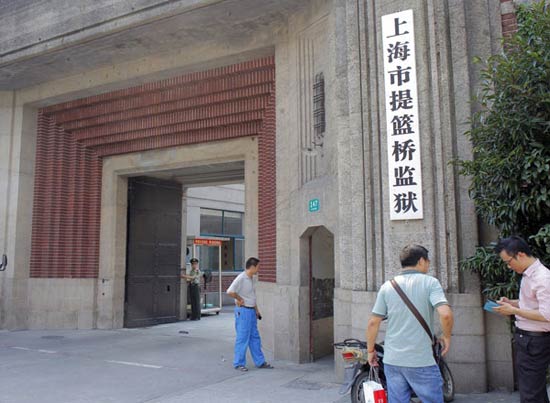
 |
| Tilanqiao Prison, the oldest existing prison in China, will be transformed into a complex of business and commercial buildings. Gao Erqiang / China Daily |
In the near future, businessmen in downtown Shanghai will be making deals in what was once the largest prison in the Far East.
Tilanqiao Prison, currently the oldest prison in China holding convicts, is making way for a mixed-use complex of business and commercial office buildings north of the Bund in Hongkou district.
Built 110 years ago by the British, the prison will apparently be preserved and renovated by several city government departments, though no specific timetable has been determined, said Zhao Ming, deputy director for publicity in Hongkou district.
"The functional transition of the prison will take place," he said Tuesday.
With Shanghai's skyrocketing population, the only jail in the city's downtown area is considered a hot property. Members of the district committee of the Chinese People's Political Consultative Conference, a local advisory body, have been urging the city government since 2011 to relocate the prisoners.
The building, which takes up nearly 40,000 square meters, is seen as a hindrance to the area's development and to the Shanghai government's plan of becoming an international shipping and financial center.
"The Tilanqiao Prison will become a lonely island in the area and influence the image and investment environment of the North Bund if it remains," said committee chairman Guan Weiyong.
Shanghai's bureau of urban planning and land resources wants the prison to be used as "a tourist and cultural center, supported by commercial and business use and community services". Alternative plans include a prison museum, a complex for creative design industries, office buildings and a community library.
Some residents in the area support turning the prison into a museum.
"We're very curious about what happened inside the heavily guarded prison with a history of more than 110 years," said Gong Zhiqiang. "It would be a perfect option to reconstruct it as a museum, which can also work as a legal education base."
Miao Xiaobao, one of the members of the district committee supporting the mixed-use complex proposal, said the government will be cautious with the renovation because the prison is a nationally protected cultural relic, the only one among 681 prisons nationwide.
Tilanqiao Prison was built to hold those convicted of crimes in the Shanghai International Settlement. The first prisoners were sent there in May 1903.
Initially, there were 480 cells across two four-story blocks. In 1935, it was expanded to 4,000 cells to accommodate 8,000 inmates across six prison blocks. There was also a block for juvenile inmates surrounded by a 5-meter-high wall.
Among the 12 prisons in Shanghai, Tilanqiao mostly holds prisoners with sentences of 10 years or more. It also holds convicts serving life or facing suspended death sentences of two years.
Wu Beimin, who lives near Tilanqiao, said she welcomes the rebuilding.
"Shanghai people equate Tilanqiao with the jail. People were always wide-eyed with astonishment when I said I live in Tilanqiao, as if I was a convict or something," said Wu, who has lived there for decades.
Several well-known people have been imprisoned at Tilanqiao, including Zhou Zhengyi, a Shanghai property tycoon who once ranked China's 11th richest man, and Yang Jia, a Beijing man who stabbed six Shanghai police officers to death on July 1, 2008, and was later executed.

















 Wild Siberian tiger kills cattle in NE China
Wild Siberian tiger kills cattle in NE China


![]()
